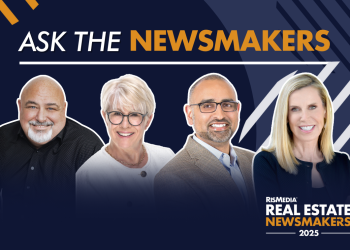RISMEDIA, March 12, 2009-Whether you are new to real estate or a seasoned veteran, you must be aware that consumers are using the Internet as the cornerstone of finding a home to buy. Year after year the influence of the Internet is measured by many – including the 2008 National Association of Realtors® Profile of Home Buyers and Sellers Study which reports:
-33% started their home search by looking online for properties for sale – 38% if a repeat buyer, 27% if a first-time buyer
-87% claim that they used the Internet as an information source – 89% if a first-time buyer and 86% if a repeat buyer.
-81% found the Internet as a useful source of information.
It is clear that brokers and agents must meet consumer demand for property information online if they are to have success in marketing homes to today’s homebuyer. Until now, brokers have relied on IDX data feeds that typically update every active MLS listing everyday. The fields that are contained in the IDX feed vary by market, but fall short of displaying all of the information available in the MLS. With a VOW (Virtual Office Website), brokers may now obtain a data feed from their MLS that contains all non-confidential information available. This represents an enormous opportunity for brokers and agents to differentiate themselves from other websites by providing homebuyers with the best website listing content available.
Google shows 88 million real estate websites that are available to consumers rising from the wake of buyers going online to view property information. The battle for online superiority rages in every corner of every neighborhood of every city in the nation between two different types of websites – IDX and non-IDX.
IDX or Internet Data Exchange rules allow brokers to display some of the key features of a home on their website. IDX is also commonly referred to as broker reciprocity where all brokers are willing to offer their listings for display on other broker sites in exchange for the ability to display all of the listings on their website. This orderly system of reciprocity comes with rules and regulations regarding display of that data. While IDX websites provide consumers with valuable information, they fall short of allowing buyers to gain access to deep levels of information that is important in their home search. To learn about days on market, price changes, tax information, sold history and other important types of information, they need to contact a real estate agent to find it for them in the MLS.
With a VOW website, homebuyers are now able to essentially access the MLS through their real estate professional. A broker may now obtain a data feed of all non-confidential information in the MLS and make that information available on their Virtual Office Website. Consumers will be able to view information that is very important to them as they look to purchase a home. They can view days on market, tax information, sold history and price changes. The real estate professional providing the information can provide better information than other websites and provide it through branded communications helping the agent to nurture an automated, online relationship with a buyer.
Agent in the center of the conversation
The same principals of working with buyers that apply to your IDX website hold true for your Virtual Office Website. An agent’s goal is to provide opportunities to engage a consumer to help them in their home search.
Most notable features for achieving this are:
Inquire about This Listing
Request a Showing
Save Listing to Favorites
Save a Search
Email a Friend
With Virtual Office Websites, the opportunity for new forms of engagement with your customer become available, which keep the servicing agent in the center of the online behavior of the agent. With VOW, these new features of consumer engagement emerge:
Agents and clients can leave notes or remarks for each other about listings.
Agents and clients can modify search criteria
Clients can reject listings that they are not interested in
Agents can view their client’s click through activity
Open House Notifications
Other than Listingbook and a few other VOW products, this functionality has not been presented to consumers before. They represent an expansion of the opportunity for engagement and conversation with your buyer within the body of a listing detail page.
Leaving a Note for my Agent – this is pretty straightforward. This functionality allows the agent and the buyer to chat about a listing, and have a record of that communication preserved for the buyer and agent to refer back to at any time. As new listings come on the market, the agent can share remarks for their buyer. The buyer can respond to those remarks and even ask a few questions of their own. Although this online conversation happens mostly by email, it could conceivably contain live chat features too.
Reject a Listing – As buyers narrow down their preferences, it is helpful to discard homes they do not have any interest in. Reject a Listing will remove those homes from the clutter and allow buyers to focus on new listings, homes that they are watching for a more affordable price, or homes they want to make an offer on.
Open House Notifications – Notify your buyers of open houses that match their search criteria. Doing this in a manner that supports and reinforces the buyer/agent relationship is critical. While many agents have a hard time grasping the idea of sending their buyer to another agent’s open house, with a VOW relationship the buyer loyalty is almost always maintained.
Stay With Your Customer
The most important skill set that a broker or agent will need to focus on with their VOW is paying attention. If you offer a VOW site to your buyer, make sure that you are committed to responding to them in a reasonable amount of time. Most VOW solutions notify you of activity by your customers on your site by email. It is important to check your email at least two or three times a day or more to keep up with your client activity. Doing so will allow you to build a stronger relationship with your customer by learning their likes and dislikes, and paying close attention to the characteristics of the property types they are searching.
Much can also be gleaned by the pattern of sign-on activity of your customer. Do they search every day or once a week, or once a month? Knowing this may help you appreciate their urgency. Have they changed their price criteria or area criteria, or added a new amenity? Are they searching for comparable homes in their neighborhood to understand the value of their home? Remember, most sellers start out as buyers first. Knowing exactly when a customer becomes active and exactly what they are viewing gives the agent the best change of securing a sale. VOW’s in no way replace the opportunity for you to consult with your client via phone or in person. They simply provide you with a good place to start a conversation.
Promote your VOW everywhere you can
In the marketing of your services, there are a variety of other touch points where you can offer VOW access. Accessing all of the non-confidential information available from the MLS is a tremendously powerful offer to consumers. Be sure to offer access to your VOW at every open house, every mixer, every featured listing on your website, every listing flyer, every business card – anywhere you can. Make it the first service you offer to any buyer you come in contact with.
Make it your goal to have a VOW available for providing services to your buyers as soon as you possibly can. Brokers and agents who are quick to respond are likely to get the most number of registered users and generate the most amount of word of mouth advertising as people begin talking about it to their friends and families.
Victor Lund is a partner with WAV Group. For more information, visit http://wavgroup.com










